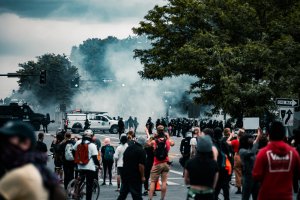
Protests happen all over the world on a daily basis. If you take the ten largest from recent history, you’ll realize that almost half of them occurred in the US — Earth Day in 1970, Anti Iraq War in 2003, Women’s March in 2017, and Black Lives Matter in 2020. While the purpose of most protests is peace, education, and unity, things can become violent at times. In 2020, at least 25 people lost their lives due to political unrest in the US. Even if you don’t participate in rallies yourself, you could still be vulnerable when peaceful protests turn violent.
Why Do People Protest?
With the First Amendment, Americans have the freedom of speech, the press, assembly, and the right to petition the government for a redress of grievances. Therefore, when controversial events occur and become highly publicized, the scales are tipped and people can unite together to fight for change. In the US, people often come together collectively to address shared issues through political activism and protest. The shared identity, purpose, courage, and resentment mobilize people to face their helplessness and vulnerability.
Why Do Some Protests Turn Violent?
Outrage — it’s usually the initial response to issues of injustice, abuse, inequality, and other catalysts. Although many people feel passionate about their cause and march to protest, they often do not turn violent. So why are some demonstrations peaceful and others destructive?
- Collective frustration – If an issue has been demonstrated too many times and no change has been made, some protesters feel the need to physically establish their existence. They feel that perhaps by breaking things and vandalizing, their presence would be acknowledged and they would finally be heard.
- Distrust of local government – In some states where government officials and other agencies are cooperative in solving issues, individuals are less likely to resolve in violence as they can coordinate with law enforcement, the court, and others in addressing matters. In other states where citizens feel the opposite about their local government, they feel that they have to do more to be heard i.e. unpeaceful protests.
- Disorganized gathering – According to research, riots happen when the protest is spontaneous and unorganized. The majority of the demonstrations, which are peaceful, are properly planned and well coordinated.
- Heavy-handed policing – The way authorities handle things can spark violent responses among protesters. If there is an aggressive police response then protestors can feel pressured into retaliating.
- Anonymity – Humans have the tendency to perform actions in large groups that they otherwise wouldn’t do when operating alone. Being in a group makes some individuals believe that they wouldn’t be held accountable as an individual with whatever they do as a group.
How to be Safe During a Protest
Protests are inevitable. Whether you participate in one or not, you will witness or be close to one at some point in life. So how do you keep yourself safe from potential violence in protests?
When participating in a protest
- Use the buddy system
- Let a friend or family member know where you are going
- Learn your rights in case you get stopped by the police
- Fully charge your phone so you can use it in case of an emergency
- Stay hydrated and nourished
- Stay focused and vigilant of your surroundings
For nonparticipants:
- Stay updated on the news
- Be vigilant in areas where demonstrations are going on
- Know your way around the places you go to
- Familiarize yourself with alternative routes
- If you come across a violent protest, don’t stay to watch
- If you need to pass through a violent protest, go with a friend
As long as we live in a world where injustice occurs and where voices continue to go unheard, protests are bound to happen. While we root for people to stand up for what is right, we can only hope that it does not turn into chaos. In the event that a peaceful protest turns violent, you need to be sure to keep your community, school, workplace, or congregation safe. Our new program for unexpected active violence in everyday life, SAVE, may be very helpful in these situations. Contact us today at https://inaheartbeatllc.com/contact/ to learn more about our Surviving Active Violence & Emergencies group classes.
Follow us on social media for more updates, facts, and tips on active violence and safety: Facebook, LinkedIn, and Twitter.